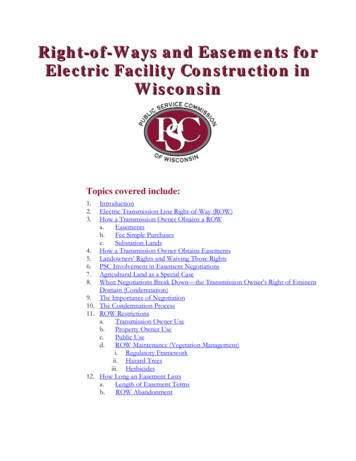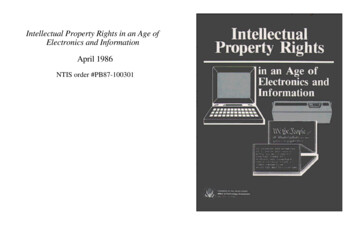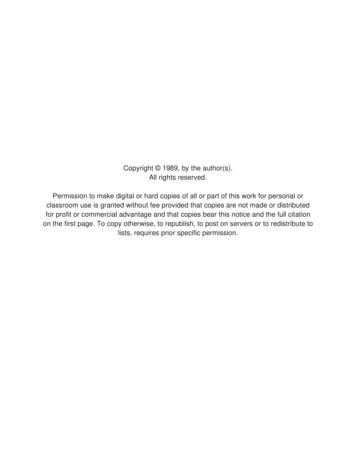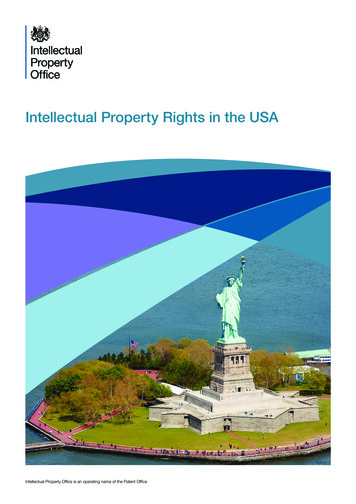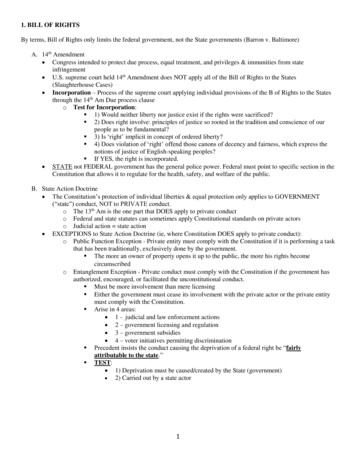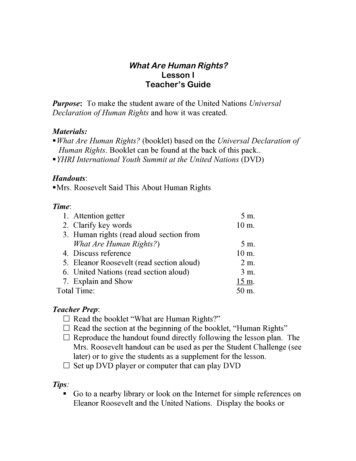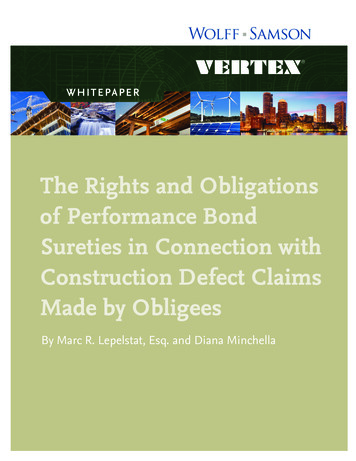
Transcription
W h i t e pa p e rThe Rights and Obligationsof Performance BondSureties in Connection withConstruction Defect ClaimsMade by ObligeesBy Marc R. Lepelstat, Esq. and Diana Minchella
THE RIGHTS AND OBLIGATIONS OF PERFORMANCE BONDSURETIES IN CONNECTION WITH CONSTRUCTION DEFECTCLAIMS MADE BY OBLIGEESMarc R. Lepelstat, Esq.Wolff & Samson PC140 Broadway, 46th FloorNew York, New York 10005(212) 973-0572I.Diana MinchellaVice PresidentVertex Construction Services, Inc.45-18 Court Square, Suite 602Long Island City, NY 11101(646) 553-3500INTRODUCTIONClaims are commonly made by project owners against performance bond suretiesfor damages sustained as a result of construction defects. Often, these claims are mademany years after the physical work on the project has been completed. These claims maystill be timely, as against completing sureties, based on separate warranty obligationswhich they may incur. A surety which has sustained a loss under its bond may seek torecoup all or a portion of its loss through its right of subrogation.This article explores the time periods in which sureties may be exposed forconstruction defect claims under New York and Connecticut law. This article alsoprovides an analysis, under New York and Connecticut law, as to the subrogation rightswhich are available to performance bond sureties in connection with losses sustained as aresult of construction defects. This article further examines whether a performance bondsurety may recover all or a portion of its losses from an insurer which issues acommercial general liability insurance policy (a “CGL policy”) naming the bondprincipal as an insured.14049958.1
A.The Exposure of Performance Bond Sureties forConstruction DefectsIf the conditions precedent of the performance bond are satisfied, the performancebond typically obligates the surety to remedy construction defects for which its bondprincipal was responsible. A commonly used bond form, the AIA Document A312Performance Bond explicitly addresses defaults consisting of construction defects. TheA312 Performance Bond provides that “if the Contractor performs the ConstructionContract, the Surety and the Contractor shall have no obligation under this Bond, exceptto participate in conferences as provided in Subparagraph 3.1.” That bond includes as acondition precedent, the declaration by the Owner of a Contractor Default. A ContractorDefault is defined as the “failure of the Contractor, which has neither been remedied norwaived, to perform or otherwise comply with the terms of the Construction Contract.”Once the Owner satisfies the conditions precedent of the bond, the A312 PerformanceBond specifically obligates the surety for “the responsibilities of the Contractor forcorrection of defective work.”The question remains as to the temporal limit of the performance bond surety’sobligation to correct any defective work of the bonded contractor or subcontractor. Thetime to sue the surety under its bond depends on the language of the bond. The A312Performance Bond provides that the suit “shall be instituted within two years after aContractor Default or within two years after the Contractor ceased working or within twoyears after the Surety refuses or fails to perform its obligations under this Bond,whichever occurs first.”Another commonly used bond form, a hybrid between the A312 and AIA-A311performance bond forms, which has been the subject of court decisions by two federal24049958.1
appeals courts1, contains the following limitations period of the time to sue under thebond: “Any suit under this bond must be instituted before the expiration of two (2) yearsfrom the date on which final payment under the Contract falls due.”2Construing an identical suit limitations provision, an appellate court in the case ofYeshiva University v. Fidelity and Deposit Company of Maryland 3 held that a completingsurety was not liable for damages occurring as a result of latent defects which werediscovered after final payment had been made for work performed under the applicablesubcontract. The action against the surety was dismissed based on the failure of theobligee to commence suit within the time permitted in the performance bond, whichprovided the following:“Any suit under this bond must be instituted before theexpiration of two (2) years from the date on which final payment under the Contract fallsdue.”4The court held that the suit under the performance bond was untimely since it wascommenced more than two years after final payment was made to the surety for workperformed under the subcontract.The appellate court in Yeshiva University reversed the order of the lower court,which had ruled in favor of the obligee and against the surety. The lower court inYeshiva University erroneously found that the existence of a defect meant that the work1Elm Haven Construction Ltd. Partnership v. Neri Construction LLC, 376 F.3d 96 (2d Cir. 2004); HuntConstr. Grp., Inc. v. Nat'l Wrecking Corp., 587 F.3d 1119, 1121 (D.C.Cir. 2009).234This limitation is also contained in the AIA-A311 performance bond.116 A.D.2d 49, 500 N.Y.S.2d 241 (1st Dept. 1986).Id., 116 A.D.2d at 50, 500 N.Y.S.2d at 243.34049958.1
had not been completed and that final payment never fell due, notwithstanding the checksent to the surety ostensibly as the final payment due under the subcontract. In itsrejection of the lower court’s construction of the subcontract and performance bond, theappeals court held the following:Such a construction leads to a somewhat startling paradox: not only was aprovision in the bond purporting to modify the otherwise applicablestatutory period of limitations read out of the bond, but, by postponingaccrual until such time as a defect became manifest, the statutory periodwas rendered inoperative as well, leaving Fidelity liable on the bond, atleast theoretically, for all time. If indeed that were the intention of theparties to the bond, their agreement would not be enforceable. 5Based on this analysis, the time to commence suit under the performance bondcontaining the language in the bond which was the subject of the Yeshiva decision,should be limited to the two-year suit limitation period contained in that bond. Thatlimitations period accrues on the “date on which final payment” under the bondedsubcontract or contract, whichever is applicable, “falls due.”However, contracts commonly provide that final payment does not become dueuntil the Contractor delivers to the Owner all guarantees and warranties which theContractor is required to provide under the Contract. If the performance bond suretyeffectuates the completion of the bonded contract pursuant to a takeover agreement, itwill likely assume each of the responsibilities which the bonded principal undertook in its5Id. at 51. The court in Yeshiva University stated in dictum that the remedy for damages attributable tothe latent defects was available against the bonded principal for a period of six years measured from thetime final payment fell due under the subcontract. The court based this dictum on the applicable statute oflimitations for breach of contract, which is set forth in New York CPLR Section 213(2).The Yeshiva University Court also noted in dictum the difference between latent and patent defects: “As arule, acceptance of performance under a construction contract is a waiver of the right to recover for defectsthat were known or discernable with reasonable inspection, i.e. patent, as opposed to latent, defects (Townof Tonawanda v. Stapell, Mumm & Beals Corp., 240 App.Div. 472, 270 N.Y.S. 377, aff'd, 265 N.Y. 630,193 N.E. 419).” Id. at 52.44049958.1
contract, including the delivery of warranties. Once the completing surety executes anddelivers warranties to its obligee, it may assume separate contractual obligations underthose warranties, with separate contractual limitations periods for each breach of thosewarranties. Accordingly, even if the two-year suit limitations period expires under theterms of the performance bond, the surety may still have a separate obligation to performany warranties which it issues, including, but not limited to, those warranties required bythe applicable contract and specifications.For example, if the bonded contract contains a specification which provides for awritten warranty signed by the contractor, and endorsed by the materials manufacturerguaranteeing that the contractor’s work will remain structurally intact for a period of atleast thirty (30) years, the completing surety which delivers that warranty as part of theobligations which it may have assumed under a takeover agreement, may incur a separatethirty year obligation for the scope of work set forth in that warranty.A cause of action in New York based upon the breach of a contractual warrantyfor the provision of services is governed by the six-year Statute of Limitations applicableto actions founded upon breach of contract.6 The Statute of Limitations begins to run atthe time of the breach of warranty. Id. Thus, this issue may remain open for at least 36years under the scenario set forth above.7Additionally, under Connecticut law, there exists neither statutory limitationsperiods nor an enforceable contractual limitations period in an action which is6See, Marchig v. Christie’s, Inc., 762 F.Supp.2d 667, 670 (S.D.N.Y. 2011), aff’d in part , rev’d in part,430 Fed.Appx. 22, 2011 WL 2685608 (2d Cir. 2011) cf. CPLR 213(2).7In Connecticut, a six-year statute of limitations would also apply to a breach of warranty claim. Gen.Stat.§ 52–576(a).54049958.1
commenced by the state, unless specifically provided for by statute.See, State v.Lombardo Brothers Mason Contractors, Inc., 307 Conn. 412, 54 A.3d 1005 (2012). Inthat case, the State of Connecticut commenced suit against a construction managementfirm and others to recover, inter alia, damages for the allegedly defective design andconstruction of the library at the University of Connecticut School of Law. Each of thedefendants raised time based defenses, relying on statutes of limitations, statutes ofrepose8 and one defendant relying on a contractual limitations period. The court rejectedthese defenses based on the doctrine of nullum tempus occurit regi (“nullum tempus”)(no time runs against the king), a common law rule that exempts the state from theoperation of statutes of limitation and statutes of repose and from the consequences of itslaches9 in a manner similar to the closely related doctrine of sovereign immunity. Thecourt further held that to the extent that a contract by the state with one of the defendantspurported to waive the state’s immunity from the operation of a repose period set forth inGeneral Statutes § 52-584a,10 the provision was invalid because the chief deputy8“[W]hile statutes of limitation are sometimes called statutes of repose, the former bars [a] right of actionunless it is filed within a specified period of time after [an] injury occurs, [whereas] statute[s] of repose[terminate] any right of action after a specific time has elapsed, regardless of whether there has yet been aninjury.” (Internal quotation marks omitted.) Baxter v. Sturm, Ruger & Co., 230 Conn. 335, 341, 644 A.2d1297 (1994).9“Laches consists of two elements. First, there must have been a delay that was inexcusable, and, second,that delay must have prejudiced the defendant.” Kurzatkowski v. Kurzatkowski, 142 Conn. 680, 684–85,116 A.2d 906 (1955). “Laches is purely an equitable doctrine, is largely governed by the circumstances,and is not to be imputed to one who has brought an action at law within the statutory period.” A.Sangivanni & Sons, v. F.M. Floryan & Co., 158 Conn. 467, 474, 262 A.2d 159 (1969).10General Statutes § 52–584a provides in relevant part:(a) No action or arbitration, whether in contract, in tort, or otherwise, (1) to recoverdamages (A) for any deficiency in the design, planning, contract administration,supervision, observation of construction or construction of, or land surveying inconnection with, an improvement to real property; (B) for injury to property, real orpersonal, arising out of any such deficiency; (C) for injury to the person or for wrongfuldeath arising out of any such deficiency, or (2) for contribution or indemnity which isbrought as a result of any such claim for damages shall be brought against any architect,64049958.1
commissioner of public works (“commissioner”) who had waived nullum tempus in thestate’s contract with one of the defendants (“Gilbane”) lacked authority to waive thestate’s immunity.In rejecting the defendants’ contention that the state was bound by the limitationsperiod set forth in the statute of repose, the court reaffirmed a general principle, traceableto English common law, pursuant to which a statutory provision limiting rights is not tobe construed as applying to the state unless the statutory language expressly or bynecessary implication provides otherwise. The court stated that this general principleapplies to statutes restricting the time period within which an action may be brought. Thecourt added that there was no substantive distinction between statutes of limitations andstatutes of repose. The court held that since the statutes of limitations and repose raisedby the defendants did not contain language which compelled the conclusion that thosestatutes applied to the state, they were inapplicable to the state’s claims against thedefendants.11professional engineer or land surveyor performing or furnishing the design, planning,supervision, observation of construction or construction of, or land surveying inconnection with, such improvement more than seven years after substantial completion ofsuch improvement.(b) Notwithstanding the provisions of subsection (a) of this section, in the case of such aninjury to property or the person or such an injury causing wrongful death, which injuryoccurred during the seventh year after such substantial completion, an action in tort torecover damages for such an injury or wrongful death may be brought within one yearafter the date on which such injury occurred, irrespective of the date of death, but in noevent may such an action be brought more than eight years after the substantialcompletion of construction of such an improvement.11The defendants contended that the state’s claims were barred by the periods of repose contained inGeneral Statutes §§ 52–577 (governing actions founded upon a tort); 52–577a (governing product liabilityclaims); 52–584 (governing actions for injury to person, or to real or personal property, caused bynegligence, or by reckless or wanton misconduct) and 52–584a (set forth in footnote 10 above) and thelimitation period set forth in General Statutes § 52–576 (governing actions for breach of contract).74049958.1
Gilbane contended that the state should not be permitted to avoid its contractualobligations, and to conclude otherwise thwarts the ability of the parties to rationallyallocate and rely on the risks and costs of their bargain. The court rejected this argumentand held the following:(I)t is not for this court to decide whether nullum tempus issound policy generally or whether the interests it serves aremore important than those served by the enforcement ofcontractual repose provisions. That decision rests solelyand exclusively in the hands of the legislature, and, to date,the legislature has not seen fit to abrogate the doctrine ofnullum tempus. To the extent that the commissionerpurported to contractually waive the state's immunity fromthe repose period of § 52–584a, he lacked the authority todo so, and, consequently, the provision is a nullity.12Based on this holding in Lombardo Brothers, a court could find that a limitationsperiod contained within a performance bond constitutes a contractual limitations period,which would be unenforceable against the state, unless specifically waived, underConnecticut law, pursuant to the doctrine of nullum tempus.The decision bearssignificant repercussions for projects in the State of Connecticut. Nullum tempus, which,absent the applicability of a contrary statute, allows the State to file suit ad infinitum, mayincrease the difficulty in obtaining insurance coverage and bonding and may increase thecost of such coverage.12In Suffolk County Water Authority v. H. T.Schneider, 288 A.D.2d 297, 733 N.Y.S.2d 441 (2d Dept.2001), a New York appeals court, in dismissing an action brought by the Suffolk County Water Authorityas untimely, rejected the Water Authority’s argument that the doctrine of nullum tempus precluded theapplication to that case of any Statute of Limitations. However, the court did not make clear whether itsholding was limited to the plaintiff in that case, the Water Authority, or whether the holding was intendedto have broader application to actions commenced by the state under New York law.84049958.1
A practical aspect of statutes of limitations and repose is also overlooked by thisdecision; the actual people involved in the project may no longer be alive to providetestimony or may no longer recall useful information. As such, this decision bolsters theimportance of proper document control and photographic documentation for constructionmanagers and contractors.Project documentation should be retained digitallyindefinitely.Additionally, this decision has significant legal implications. In nullifying thecommissioner’s waiver of immunity, the decision calls into question the enforceability ofcommon contract provisions and the jurisdiction of executive officers in entering legallybinding contractual repose provisions.94049958.1
II.THE PERFORMANCE BOND SURETY’S RIGHT OF RECOUPMENTUNDER A CGL POLICYA.The Surety’s Right Of Subrogation1.New York LawA performance bond surety which sustains a loss in connection with a claim forconstruction defects must consider whether it is able to recoup all or a portion of its lossfrom third parties which may be liable. Under New York law, a surety who answers forthe default of his principal pursuant to the terms of a performance bond, either bycompleting the work required under the principal's contract with the owner-obligee, or bypaying compensation to the owner-obligee, is entitled to be subrogated to the rights of theobligee whom he has paid, or on whose behalf he has completed the contract.13Based on this principle, performance bond sureties, as subrogees of projectowners have been permitted to assert breach of contract claims against culpable thirdparties with whom the owners had contractual relationships, including architecturalfirms14 and construction managers.1513See, Menorah Nursing Home, Inc. v. Zukov, 153 A.D.2d 13, 17, 548 N.Y.S.2d 702, 705 (2d Dept. 1989);cf. Pearlman v. Reliance Ins. Co., 371 U.S. 132, 83 S.Ct. 232, 9 L.Ed.2d 190 (1962); Scarsdale Nat. Bank& Trust Co. v. United States Fid. & Guar. Co., 264 N.Y. 159, 190 N.E. 330 (1934); Kolb v. NationalSurety Co., 176 N.Y. 233, 68 N.E. 247 (1903); Lewis v. Palmer, 28 N.Y. 271 (1863); State Bank of Albanyv. Dan–Bar Contr. Co., Inc., 23 Misc.2d 487, 199 N.Y.S.2d 309 (Sup. Ct., Albany Co. 1960); affd. 12A.D.2d 416, 212 N.Y.S.2d 386 (3d Dept. 1961); affd. 12 N.Y.2d 804, 235 N.Y.S.2d 835, 187 N.E.2d 19(1962); American Surety Co. of N.Y. v. Town of Islip, 268 A.D. 92, 48 N.Y.S.2d 749 (2d Dept. 1944); 63N.Y.Jur.2d, Guaranty and Suretyship, §§ 440, 585; Simpson, Suretyship § 47; McClintock, Equity § 123(2d ed.).14Am. Man. Mut. Ins. Co. v. Payton Lane Nursing Home Inc., No. CV 05-5155, 2007 WL 674691(E.D.N.Y., Feb. 28, 2007).15Aetna Cas. & Sur. Co. v. Manshul Constr. Corp., 95 CIV 3994, 2001 WL 225043 (S.D.N.Y., Mar. 6,2001).104049958.1
However, the right of a surety under these circumstances to be subrogated to therights of its obligee is not exclusive of all other equitable subrogation rights. The generalrule is that, upon answering for the default of its principal, a surety may be subrogated toany claims which the defaulting principal might have against th
A. The Exposure of Performance Bond Sureties for Construction Defects If the conditions precedent of the performance bond are satisfied, the performance bond typically obligates the surety to remedy construction defects for which its bond principal was responsible. A commonly us

